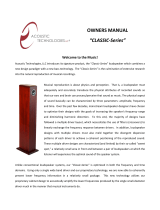
3
33
3
absolute fidelity
nearest wall being different.
As the room will greatly influence the sound of your system, fine-
tuning adjustments in placement will be necessary. Every room will
be different, with doorways, closets, wall construction and covering,
etc. all making a significant impact on positioning.
Unpacking
The Genesis 2.2 system will arrive in a number of pieces. There
are four large wooden shipping crates, two containing the woofer
towers, two holding midrange/tweeter panels (or “wings”). There
will also be a pallet of cardboard boxes holding the acoustic
suspension system, the various modules of the servo-controlled
bass amplifier, and a box containing the various cables. (There
could also be up to three more boxes if you have the dynamic
reservoir and power supply upgrades to the servo-controlled bass
amplifier.)
To remove the contents of all the crates, you will need help. The
G2.2 loudspeaker system with crates weigh a total of 1,400 lbs.
Each woofer tower weighs over 220 lbs, and each tweeter tower
weighs over 150 lbs and they have to be lifted out of the shipping
crates. We are not liable for damage (to either the speakers or
your backs!) during unpacking and setting up.
We suggest the use of a forklift to move these
crates around, and at least four strong people to
un-box and position the loudspeakers. In order to
remove the loudspeakers from the crates, the front
and top of the crates can be removed. This is
secured with screws – remove all exposed screws
except the ones marked with blue paint – and the
top and front can be lifted away.
With the top and front of the crate removed, each
wing and tower of the loudspeaker can be carefully
lifted and slid out of the crate. Before you put the speaker up on its
feet, it will be necessary to install the acoustic suspension (next
page).
After unpacking, we strongly suggest that the crates be dismantled,
flattened and safely stored away in a cool, dry place. They will be
needed should you relocate or move. It will be expensive to custom




















